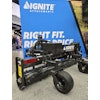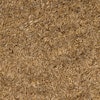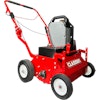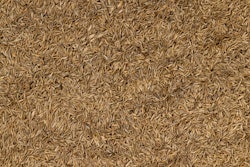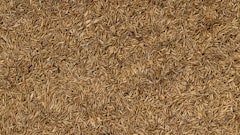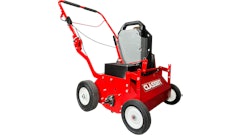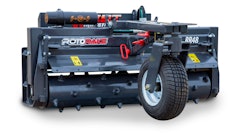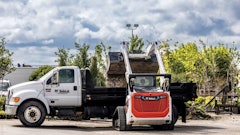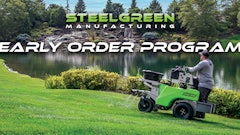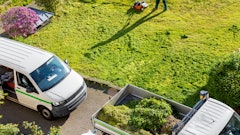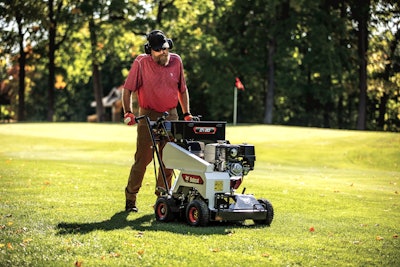
When it comes to maintaining healthy turf, watering and mowing are only part of the equation. Two lesser-known but highly impactful practices are aeration and overseeding. Together, they improve soil structure, enhance nutrient absorption, and promote thicker, more resilient turf.
Fall provides ideal conditions for many cool-season grass types to recover from summer stress and prepare for the cooler months ahead. By understanding the benefits and best practices of aeration and overseeding, both professionals and property owners can ensure their lawns stay lush, vibrant, and sustainable year after year.
Without aeration and overseeding, lawns are more likely to become patchy, thin, and nutrient-deprived over time, particularly during long dry spells.
Aeration is the process of using a machine to create small holes in the soil by removing plugs or slices of turf. This allows air, water, and nutrients to penetrate deeply into the root zone, relieving compaction and fostering root development. Overseeding is the practice of spreading grass seed directly over existing turf to fill in thin areas or help establish new growth.
On their own, each process offers clear benefits. Together, they create healthier soil, improved drainage, stronger roots, and more resilient turf that can withstand drought, disease, and heavy foot traffic. Without aeration and overseeding, lawns are more likely to become patchy, thin, and nutrient-deprived over time, particularly during long dry spells.
Incorporating these practices into a yearly lawn care plan offers numerous advantages. Aeration reduces compaction, increases water infiltration, and encourages beneficial microorganisms in the soil. Overseeding introduces new grass varieties that are often more disease- and insect-resistant while improving density and color.
The best time for aeration and overseeding depends on the type of grass you have.
Beyond appearance, these practices are cost-effective ways to extend the life of turf and reduce long-term maintenance needs. For property owners, the investment pays off with improved curb appeal, reduced runoff, and healthier soil for surrounding plants. For landscape professionals, aeration and overseeding provide a valuable opportunity to educate clients on proactive lawn care that yields lasting results.
Timing Matters: Cool vs. Warm Season Grasses
The best time for aeration and overseeding depends on the type of grass you have:
- Cool season grasses such as Kentucky bluegrass and perennial ryegrass can be aerated in the early spring but respond best to fall aeration and overseeding. Cooler temperatures and consistent moisture create optimal conditions for germination and root development. This timing helps turf establish before winter dormancy.
- Warm season grasses like Bermuda and zoysia thrive when aerated in late spring or early summer, once soil temperatures reach about 70°F. Overseeding at this time ensures seeds take advantage of warm, active growth cycles.
For fall-focused turf care in cooler climates, scheduling aeration and overseeding between late August and early October typically delivers the strongest results.
More seasonal work on GreenIndustryPros.comFall Lawn Care Tips - These fall lawn care tips will ensure lawns come back full and healthy following the winter season. How to Prevent Lawn Disease in the Fall - Check out these recommendations for preventing lawn disease during fall. Using Late-Fall Fertilization to Win New Customers - The better you understand the advantages of late-fall fertilization, the better you can implement your own program, and market it to both potential and existing customers. Consider a Winter Lawn Care Plan - Tips from TruGreen help make lawns a lasting impression. |
Signs Your Lawn Needs Attention
Not every lawn requires aeration and overseeding on the same schedule. Key indicators that your turf could benefit from the process include:
- Water puddling or runoff
- Thin, discolored or uneven grass
- Dry, compacted, or clay-heavy soil
- Thatch buildup greater than ½ inch
- Visible foot traffic patterns
- Inability for turf to receive or retain moisture
Addressing these issues early helps prevent larger problems and reduces the likelihood of turf failure in the future.
 The Bobcat AE30S Stand-On Aerator can cover over 2 acres per hour, reaching ground speeds of up to 7 mph, making quick work of large areas. Its 30-in. working width and 48 durable, hardened alloy steel coring tines ensure deep and consistent aeration, penetrating up to 5 in. to promote healthy root growth and turf vitality. It features an anti-vibration stand-on platform that can be folded for walk-behind operation. All controls are intuitively placed on the operator station for easy access. Patented depth stops guarantee uniform results across the turf, while the cooling, automatic chain tensioner systems, and integrated jack-stands enhance durability and simplify maintenance. Powered by a 15 hp Kawasaki engine, the AE30S is a reliable investment for any professional aiming for pristine turf conditions. Optional accessories like a seed spreader and light kit further enhance its versatility.Bobcat Company
The Bobcat AE30S Stand-On Aerator can cover over 2 acres per hour, reaching ground speeds of up to 7 mph, making quick work of large areas. Its 30-in. working width and 48 durable, hardened alloy steel coring tines ensure deep and consistent aeration, penetrating up to 5 in. to promote healthy root growth and turf vitality. It features an anti-vibration stand-on platform that can be folded for walk-behind operation. All controls are intuitively placed on the operator station for easy access. Patented depth stops guarantee uniform results across the turf, while the cooling, automatic chain tensioner systems, and integrated jack-stands enhance durability and simplify maintenance. Powered by a 15 hp Kawasaki engine, the AE30S is a reliable investment for any professional aiming for pristine turf conditions. Optional accessories like a seed spreader and light kit further enhance its versatility.Bobcat Company
Preparing for Aeration & Overseeding
Proper preparation is key to successful results. Here are several steps to take before starting:
- Clear the turf of debris such as branches, leaves, or lawn clippings.
- Mow slightly shorter than normal for a final seasonal cut.
- Water the area one to three days before aerating to soften the soil without oversaturating it.
- Flag sprinkler heads, irrigation lines, invisible fencing, and other underground objects to avoid damage.
- Avoid aerating newly seeded or sodded lawns until they have matured for at least one year.
While many homeowners choose to hire lawn care professionals for aeration and overseeding, equipment rentals make it possible for individuals to take on the task themselves. Aerators and overseeders can be rented at many garden centers and rental outlets, but using them effectively requires some practice. Professionals, on the other hand, bring expertise in timing, technique, and soil analysis — ensuring the greatest return on investment.
Aeration and overseeding are straightforward, cost-effective practices that deliver outsized benefits to turf health. By improving soil structure, encouraging root development, and introducing resilient grass varieties, these steps create lawns that are more vibrant, durable, and sustainable. Fall offers the perfect opportunity to incorporate them into an annual lawn care plan, ensuring that turf not only survives the challenges of summer but thrives in the seasons ahead.
